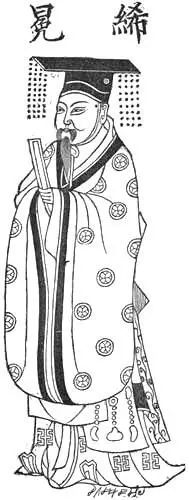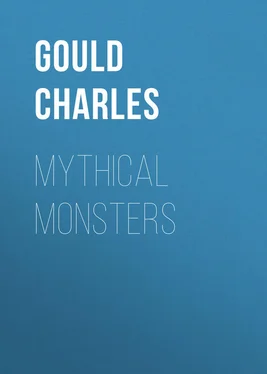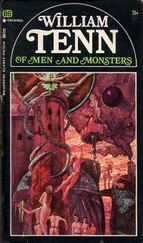Charles Gould - Mythical Monsters
Здесь есть возможность читать онлайн «Charles Gould - Mythical Monsters» — ознакомительный отрывок электронной книги совершенно бесплатно, а после прочтения отрывка купить полную версию. В некоторых случаях можно слушать аудио, скачать через торрент в формате fb2 и присутствует краткое содержание. Жанр: Мифы. Легенды. Эпос, Природа и животные, foreign_antique, foreign_prose, на английском языке. Описание произведения, (предисловие) а так же отзывы посетителей доступны на портале библиотеки ЛибКат.
- Название:Mythical Monsters
- Автор:
- Жанр:
- Год:неизвестен
- ISBN:нет данных
- Рейтинг книги:5 / 5. Голосов: 1
-
Избранное:Добавить в избранное
- Отзывы:
-
Ваша оценка:
- 100
- 1
- 2
- 3
- 4
- 5
Mythical Monsters: краткое содержание, описание и аннотация
Предлагаем к чтению аннотацию, описание, краткое содержание или предисловие (зависит от того, что написал сам автор книги «Mythical Monsters»). Если вы не нашли необходимую информацию о книге — напишите в комментариях, мы постараемся отыскать её.
Mythical Monsters — читать онлайн ознакомительный отрывок
Ниже представлен текст книги, разбитый по страницам. Система сохранения места последней прочитанной страницы, позволяет с удобством читать онлайн бесплатно книгу «Mythical Monsters», без необходимости каждый раз заново искать на чём Вы остановились. Поставьте закладку, и сможете в любой момент перейти на страницу, на которой закончили чтение.
Интервал:
Закладка:
“By the work ( Principles of Geology , vol. iii.), as a whole, was dealt the most telling blow that had ever fallen upon those to whom it appears ‘more philosophical to speculate on the possibilities of the past than patiently to explore the realities of the present,’ while the earnest and careful endeavour to reconcile the former indications of change with the evidence of gradual mutation now in progress, or which may be in progress, received its greatest encouragement. The doctrines which Hutton and Playfair had held and taught assumed new and more vigorous life as better principles were explained by their eminent successor, and were supported by arguments which, as a whole, were incontrovertible.” – Annual Address, President of Geological Society, 1876.
“But, as Sir Roderick Murchison has long ago proved, there are parts of the record which are singularly complete, and in those parts we have the proof of creation without any indication of development. The Silurian rocks, as regards oceanic life, are perfect and abundant in the forms they have preserved. Yet there are no fish. The Devonian age followed tranquilly and without a break, and in the Devonian sea, suddenly, fish appear, appear in shoals, and in form of the highest and most perfect type.” – The Duke of Argyll, Primeval Man , p. 45, London, 1869.
73
T. Mellard Reade, “Limestone as an Index of Geological Time,” Proceedings , Royal Society, London, vol. xxviii., p. 281.
74
Scientific American , Supplement, February 1881.
75
Proceedings , Royal Society, vol. xv. No. 82, 1866.
76
Athenæum , August 25, 1860, &c.
77
The mass of astronomers, however, deny that this is possible to any very great extent.
78
James Croll, F.R.S., &c., Climate and Time in their Geological Relations .
79
Figs. 19and 21are taken, by permission of Edmund Christy, Esq., from Reliquiæ Aquitanicæ , &c., London, 1875.
80
In some cases as much as 150 feet.
81
“Starting from the opinion generally accepted among geologists, that man was on the earth at the close of the Glacial epoch, Professor B. F. Mudge adduces evidence to prove that the antiquity of man cannot be less than 200,000 years.
“His argument, as given in the Kansas City Review of Science, is about as follows: —
“After the Glacial epoch, geologists fix three distinct epochs, the Champlain, the Terrace, and the Delta, all supposed to be of nearly equal lengths.
“Now we have in the delta of the Mississippi a means of measuring the duration of the third of these epochs.
“For a distance of about two hundred miles of this delta are seen forest growths of large trees, one after the other, with interspaces of sand. There are ten of these distinct forest growths, which have begun and ended one after the other. The trees are the bald cypress ( Taxodium ) of the Southern States, and some of them were over twenty-five feet in diameter. One contained over five thousand seven hundred annual rings. In some instances these huge trees have grown over the stumps of others equally large, and such instances occur in all, or nearly all, of the ten forest beds. This gives to each forest a period of 10,000 years.
“Ten such periods give 100,000 years, to say nothing of the time covered by the interval between the ending of one forest and the beginning of another, an interval which in most cases was considerable.
“‘Such evidence,’ writes Professor Mudge, ‘would be received in any court of law as sound and satisfactory. We do not see how such proof is to be discarded when applied to the antiquity of our race.
“‘There is satisfactory evidence that man lived in the Champlain epoch. But the Terrace epoch, or the greater part of it, intervenes between the Champlain and the Delta epochs, thus adding to my 100,000 years.
“‘If only as much time is given to both those epochs as to the Delta period, 200,000 years is the total result.’” — Popular Science Monthly , No. 91, vol. xvi. No. 1, p. 140, November 1878.
82
Such as the destruction of the Alexandrine Library on three distinct occasions, (1) upon the conquest of Alexandria by Julius Cæsar, B.C. 48; (2) in A.D. 390; and, (3) by Amrou, the general of the Caliph Omar, in 640, who ordered it to be burnt, and so supplied the baths with fuel for six months. Again, the destruction of all Chinese books by order of Tsin Shi Hwang-ti, the founder of the Imperial branch of the Tsin dynasty, and the first Emperor of United China; the only exceptions allowed being those relating to medicine, divination, and husbandry. This took place in the year 213 B.C.
83
The Chinese have used composite blocks (wood engraved blocks with many characters, analogous to our stereotype plates) from an early period. May not the brick-clay tablets preserved in the Imperial Library at Babylon have been used for striking off impressions on some plastic material, just as rubbings may be taken from the stone drums in China: may not the cylinders with inscribed characters have been used in some way or other as printing-rollers for propagating knowledge or proclamations?
84
As, for example, the old canal from the Nile to the Red Sea, in reference to which Herodotus says ( Euterpe , 158), “Neco was the son of Psammitichus, and became King of Egypt: he first set about the canal that leads to the Red Sea, which Darius the Persian afterwards completed. Its length is a voyage of four days, and in width it was dug so that two triremes might sail rowed abreast. The water is drawn into it from the Nile, and it enters it a little above the city Bubastis, passes near the Arabian city Patumos, and reaches to the Red Sea.” In the digging of which one hundred and twenty thousand Egyptians perished in the reign of Neco.
85
The co-called tanks at Aden, reservoirs constructed one below the other, in a gorge near the cantonments, are as perfect now as they were when they left the hand of the contractor or royal engineer in the time of Moses.
86
In the 29th year of the Emperor Kwei [B.C. 1559] they chiselled through mountains and tunnelled hills, according to the Bamboo Books.
87
An interesting line of investigation might be opened up as to the origin of inventions and the date of their migrations. The Chinese claim the priority of many discoveries, such as chess, printing, issue of bank-notes, sinking of artesian wells, gunpowder, suspension bridges, the mariner’s compass, &c. &c. I extract two remarkable wood-cuts from the San Li T’u , one appended here showing the origin of our college cap; the other, in the chapter on the Unicorn, appearing to illustrate the fable of the Sphynx.

Fig. 22. – Royal Diademof the Chen Dynasty.
( From the San Li T’u. )
I also give a series of engravings, reduced facsimiles of those contained in a celebrated Chinese work on antiquities, showing the gradual evolution of the so-called Grecian pattern or scroll ornamentation, and origination of some of the Greek forms of tripods.
88
“The old Troglodytes, pile villagers, and bog people, prove to be quite a respectable society. They have heads so large that many a living person would be only too happy to possess such.” – A. Mitchell, The Past in the Present , Edinburgh, 1880.
Читать дальшеИнтервал:
Закладка:
Похожие книги на «Mythical Monsters»
Представляем Вашему вниманию похожие книги на «Mythical Monsters» списком для выбора. Мы отобрали схожую по названию и смыслу литературу в надежде предоставить читателям больше вариантов отыскать новые, интересные, ещё непрочитанные произведения.
Обсуждение, отзывы о книге «Mythical Monsters» и просто собственные мнения читателей. Оставьте ваши комментарии, напишите, что Вы думаете о произведении, его смысле или главных героях. Укажите что конкретно понравилось, а что нет, и почему Вы так считаете.











